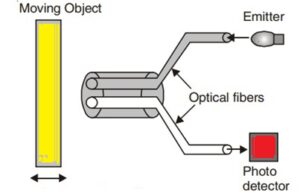How does a capacitive proximity sensor work?

The capacitive proximity sensors use the capacitor to operate, the major components of this sensor is a plate, oscillator, threshold detector, and an output circuit. So the plate and the object would act as a plate and the air would be the dielectric. So when an object comes near to the plate, then the capacitance would increase and this would trigger the detector circuit and this triggering is according to the amplitude output from the oscillator. The oscillator won’t oscillate if the material is not close to the sensor. These sensors can detect certain objects such as metal, plastic, glass, and wood, so if these objects come to the active switching zone then the capacitance would be altered and the change in capacitance is depended upon certain factors and they are, object distance from the active surface, The dimension of the object and the dielectric constant of the object.
By using a potentiometer we can change the switching of a capacitive proximity sensor and in this way, we can make these sensors not detect certain media. An example of this is we can determine the fluid level of a hydrous solution through the wall of a bottle.
What are the types of capacitive proximity sensor?
Dielectric type
In this type, there are two side-by-side capacitor plates in the sensor face, for this type the external target acts as a dielectric. So in case if any object comes near to the sensor there would be a variation in dielectric and this would increase the capacitance of the internal capacitor, due to this the oscillator amplitude would increase. This type can sense both metallic and non-metallic objects.
Conductive type
The conductive type sensor’s operation is similar to the dielectric type the difference is that there is only one capacitor plate in the sensor face and the target would be the other plate, so in this type, the target should be electrically conductive.
How to select a capacitive proximity sensor?
- It must be selected according to the sensing object
- It must be selected according to the environmental conditions
- Sensing distance must be considered because it doesn’t have long-range
- Switching frequency
- Operating voltage
What are the advantages of capacitive proximity sensor?
- It can detect non-metallic targets
- Long life
- Transparency through certain materials
- It can detect metals, non-metals, liquids, and solids
- Low cost
- High speed
- It would only use low power
- Better resolution stability
- It can handle high shock loads and vibrations
What are the disadvantages of capacitive proximity sensors?
- Changes in environmental conditions would badly affect this sensor
- They only have short-range
- These sensors must be clean otherwise it could fail
- It won’t be able to detect materials that have the same dielectric constant as the air
- It can be set to be more sensitive and this could create false tripping
- These sensors are not suitable for polystyrene and also for similar objects that have low density
What are the applications of capacitive proximity sensor?
- It is used for vehicle parking assist
- It is also used for pre-crash sensing in vehicles
- Adaptive cruise control
- Level control of non-conductive liquids

